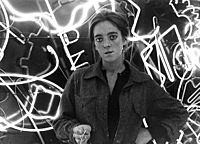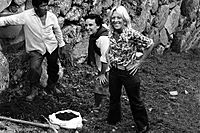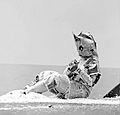Marta Minujín facts for kids
Quick facts for kids
Marta Minujín
|
|
|---|---|

Marta Minujín in 2008.
|
|
| Born | 30 January 1943 Buenos Aires, Argentina
|
| Known for | Painting, sculpture, performance, happening, drawing |
| Movement |
|
| Spouse(s) |
Juan Carlos Gómez Sabaini
(m. 1957) |
| Awards | Platinum Konex Award (1982 and 2002) |
Marta Minujín (born in 1943) is a famous Argentine artist. She is known for her unique and exciting art. Her work often includes conceptual art and performance art. Conceptual art means the idea behind the art is the most important part. Performance art involves the artist doing something, often in front of an audience.
Contents
Marta Minujín's Artistic Journey
Marta Minujín was born in Buenos Aires, Argentina. She started showing her art in 1959. A special scholarship helped her travel to Paris in 1960. There, she met other young artists.
Art That Comes Alive
In Paris, Marta was inspired by artists who wanted to turn art into real life. In 1962, she even burned her own paintings in public! This was a way to show her new ideas about art.
She also created "livable sculptures." One famous piece was La Destrucción (The Destruction) in 1963. She put mattresses together and then invited other artists to destroy them. This was one of her first "Happenings." A happening is an event that is a work of art itself.
Exciting Happenings in Argentina
When she returned to Buenos Aires, Marta created more happenings. In 1964, she made Revuélquese y viva (Roll Around in Bed and Live). She also had horses with paint buckets tied to their tails for Cabalgata (Cavalcade). This was shown on TV!
In Montevideo, she organized Sucesos (Events). This involved 500 chickens, artists, motorcycles, and other surprising things.
La Menesunda: A Walk-Through Art Piece
In 1965, Marta created La Menesunda (Mayhem) with Rubén Santantonín. Visitors walked through sixteen different rooms. Each room had a unique experience. For example, there was a room with loud TVs and another with a dental office. There was even a cold room with hanging fabrics. This art piece used ideas from pop art, which often uses images from advertising and everyday life.
Art in New York City
Marta received a special award called a Guggenheim Fellowship in 1966. This allowed her to move to New York City. There, she created the "Minuphone." People could step into a phone booth, dial a number, and see colors, hear sounds, and even see themselves on a screen.
In New York, she became friends with another famous artist, Andy Warhol.
Returning Home and New Ideas
Marta came back to Argentina in 1976. She made sculptures of classical Greek sculptures. She also made small versions of famous landmarks. For example, she made the Buenos Aires Obelisk out of a sweet bread called panettone. She even made the Venus de Milo out of cheese!
The Parthenon of Books
In 1983, Argentina became a democracy again after a time of strict government control. Marta wanted to celebrate freedom of expression. She created the "Parthenon of Books [Homage to Democracy]." She used 30,000 books that had been banned by the old government. These included books by famous thinkers and even children's stories like The Little Prince.
This temple-like structure was built on a main street in Buenos Aires. After three weeks, it was taken apart. The books were given to the public. This showed that people could now read freely again.
The Debt with Andy Warhol
Marta also created a happening called The Debt in 1985. She bought a lot of corn. She then took photos of herself giving the corn to Andy Warhol. This was a symbolic way to talk about Argentina's large foreign debt.
Later Works and Beliefs
In 2017, Marta created a second Parthenon of Banned Books in Germany. This one used 100,000 banned books. It honored books that were censored and burned by the Nazis in the 1930s and 1940s. Like her first Parthenon, the books were given away to people when the art piece was taken down.
In 2021, she made a half-size copy of London's Big Ben tower. It was called Big Ben Lying Down and was made of books about British politics. Visitors were invited to take a book from it at the end of the show.
Marta Minujín's art has been shown in many museums and galleries around the world. She continues to create art that makes people think. She is well known for her belief that "everything is art."
Gallery
-
Sweet Obelisk (1965). Minujín covered the Obelisk of Buenos Aires with ice cream, and three colleagues licked it.
-
Reading the News (1965). Minujín got into the Río de la Plata covered in newspapers.
See also
 In Spanish: Marta Minujín para niños
In Spanish: Marta Minujín para niños










